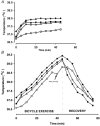Inadequate heat release from the human brain during prolonged exercise with hyperthermia
- PMID: 12456844
- PMCID: PMC2290690
- DOI: 10.1113/jphysiol.2002.030023
Inadequate heat release from the human brain during prolonged exercise with hyperthermia
Abstract
Brain temperature appears to be an important factor affecting motor activity, but it is not known to what extent brain temperature increases during prolonged exercise in humans. Cerebral heat exchange was therefore evaluated in seven males during exercise with and without hyperthermia. Middle cerebral artery mean blood velocity (MCA V(mean)) was continuously monitored while global cerebral blood flow (CBF) and cerebral energy turnover were determined at the end of the two exercise trials in three subjects. The arterial to venous temperature difference across the brain (v-aD(temp)) was determined via thermocouples placed in the internal jugular vein and in the aorta. The jugular venous blood temperature was always higher than that of the arterial blood, demonstrating that heat was released via the CBF during the normothermic as well as the hyperthermic exercise condition. However, heat removal via the jugular venous blood was 30 +/- 6 % lower during hyperthermia compared to the control trial. The reduced heat removal from the brain was mainly a result of a 20 +/- 6 % lower CBF (22 +/- 9 % reduction in MCA V(mean)), because the v-aD(temp) was not significantly different in the hyperthermic (0.20 +/- 0.05 degrees C) compared to the control trial (0.22 +/- 0.05 degrees C). During hyperthermia, the impaired heat removal via the blood was combined with a 7 +/- 2 % higher heat production in the brain and heat was consequently stored in the brain at a rate of 0.20 +/- 0.06 J g(-1) min(-1). The present results indicate that the average brain temperature is at least 0.2 degrees C higher than that of the body core during exercise with or without hyperthermia.
Figures



References
-
- Aaslid R, Markwalder T-M, Nornes H. Noninvasive trancranial Doppler ultrasound recording of flow velocity in basal cerebral arteries. Journal of Neurosurgery. 1982;57:769–774. - PubMed
-
- Bangsbo J. Quantification of anaerobic energy production during intense exercise. Medicine and Science in Sports and Exercise. 1998;30:47–52. - PubMed
-
- Borg G. Simple rating for estimation of perceived exertion. In: Borg G, editor. Physical Work and Effort. New York: Pergamon; 1975. pp. 39–46.
-
- Brengelmann GL. Specialized brain cooling in humans. FASEB Journal. 1993;7:1148–1153. - PubMed
-
- Brinnel H, Nagasaka T, Cabanac M. Enhanced brain protection during passive hyperthermia in humans. European Journal of Applied Physiology. 1987;56:540–545. - PubMed
Publication types
MeSH terms
LinkOut - more resources
Full Text Sources
Medical
Miscellaneous

